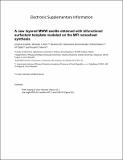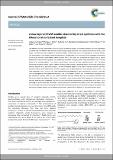Files in this item
A new layered MWW zeolite synthesized with the bifunctional surfactant template and the updated classification of layered zeolite forms obtained by direct synthesis
Item metadata
| dc.contributor.author | Grzybek, Justyna | |
| dc.contributor.author | Roth, Wieslaw J. | |
| dc.contributor.author | Gil, Barbara | |
| dc.contributor.author | Korzeniowska, Aleksandra | |
| dc.contributor.author | Mazur, Michal | |
| dc.contributor.author | Čejka, Jiří | |
| dc.contributor.author | Morris, Russell E. | |
| dc.date.accessioned | 2020-03-05T00:32:01Z | |
| dc.date.available | 2020-03-05T00:32:01Z | |
| dc.date.issued | 2019-04-07 | |
| dc.identifier | 258518974 | |
| dc.identifier | 04a54e3f-a259-4e48-809b-c2c672db7df5 | |
| dc.identifier | 85063380032 | |
| dc.identifier | 000463819400040 | |
| dc.identifier.citation | Grzybek , J , Roth , W J , Gil , B , Korzeniowska , A , Mazur , M , Čejka , J & Morris , R E 2019 , ' A new layered MWW zeolite synthesized with the bifunctional surfactant template and the updated classification of layered zeolite forms obtained by direct synthesis ' , Journal of Materials Chemistry A , vol. 7 , no. 13 , pp. 7701-7709 . https://doi.org/10.1039/C8TA09826C | en |
| dc.identifier.issn | 2050-7488 | |
| dc.identifier.other | ORCID: /0000-0001-7809-0315/work/61622172 | |
| dc.identifier.uri | https://hdl.handle.net/10023/19601 | |
| dc.description | Authors would like to acknowledge: National Science Centre Poland grants no 2016/21/B/ST5/00858 (JG, BG) and 2014/15/B/ST5/04498 (WJR, AK); OP VVV “Excellent Research Teams”, project No. CZ.02.1.01/0.0/0.0/15_003/0000417 – CUCAM (MM, JČ); EPSRC grant EP/K025112/1 and Capital for Great Technologies grant EP/L017008/1 (REM); Czech Science Foundation P106/12/G015 (JČ). We thank Dr D. N. Miller for help with the TEM and SAED. | en |
| dc.description.abstract | The medium pore-size zeolite MWW is very valuable as an industrial catalyst for aromatic alkylation and the first zeolite identified in the layered form. It shows extraordinary diversity by producing a great variety of different layered structures and forms: so far about 15 obtained by direct preparation and post-synthesis modifications, with 18 altogether recognised for all layered zeolites. We report a new layered MWW material, denoted UJM-1P (Uniwersytet Jagiellonski Material #1), which was obtained by prolonging synthesis of the mono-layered MWW material reported earlier, MIT-1. This transformation is new but not totally surprising. MIT-1 was obtained by using a special bifunctional structure directing agent (SDA) containing adamantyl head group and a long hydrocarbon chain. This strategy was applied first to produce by design layered forms of one of the most important zeolites-MFI. The MWW framework was previously obtained by direct synthesis in 5 different forms that could be rationalized by particular layer arrangements. MFI added 3 more types with two prepared, before MIT-1, with the aforementioned bifunctional SDA. MIT-1 and UJM-1P (as synthesized) and UJM-1 (calcined) are analogues of these layered MFI materials and are considered as the 6th and 7th MWW forms obtained by a direct one-pot preparation. UJM-1P has a multilayered slightly expanded structure similar to MCM-22P by with extensive layer disorder. It is easier to swell with surfactants than MCM-22P, which indicates weak interlayer connection that may be due to the special SDA molecules lining the surface of its layers. This is promising for delamination and formation of colloidal dispersions of MWW mono-layers. UJM-1 was confirmed to be a very active solid acid catalyst showing high concentration of Brønsted acid sites of about 900 μmol g−1 . It was tested in the mesitylene alkylation reaction showing high activity comparable to MCM-56, while MIT-1 was about 50% less active. | |
| dc.format.extent | 9 | |
| dc.format.extent | 942147 | |
| dc.format.extent | 779030 | |
| dc.language.iso | eng | |
| dc.relation.ispartof | Journal of Materials Chemistry A | en |
| dc.subject | QD Chemistry | en |
| dc.subject | Chemistry(all) | en |
| dc.subject | Renewable Energy, Sustainability and the Environment | en |
| dc.subject | Materials Science(all) | en |
| dc.subject | NDAS | en |
| dc.subject | SDG 7 - Affordable and Clean Energy | en |
| dc.subject.lcc | QD | en |
| dc.title | A new layered MWW zeolite synthesized with the bifunctional surfactant template and the updated classification of layered zeolite forms obtained by direct synthesis | en |
| dc.type | Journal article | en |
| dc.contributor.sponsor | EPSRC | en |
| dc.contributor.sponsor | EPSRC | en |
| dc.contributor.institution | University of St Andrews. EaSTCHEM | en |
| dc.contributor.institution | University of St Andrews. School of Chemistry | en |
| dc.identifier.doi | 10.1039/C8TA09826C | |
| dc.description.status | Peer reviewed | en |
| dc.date.embargoedUntil | 2020-03-05 | |
| dc.identifier.grantnumber | EP/K025112/1 | en |
| dc.identifier.grantnumber | ep/l017008/1 | en |
This item appears in the following Collection(s)
Items in the St Andrews Research Repository are protected by copyright, with all rights reserved, unless otherwise indicated.


